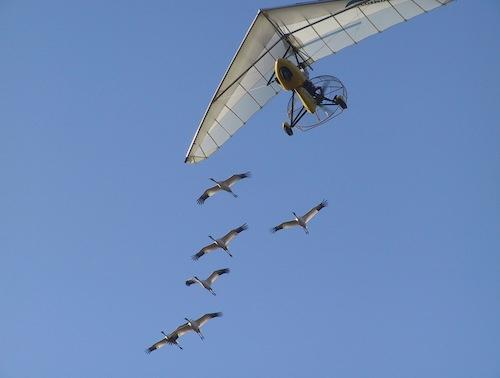
Is Migration Innate or Learned?
Whooping cranes learn their migration route from older cranes, and get better at it with age, a UMD-led research team found
COLLEGE PARK, Md – Scientists have studied bird migration for centuries, but it remains one of nature’s great mysteries. How do birds find their way over long distances between breeding and wintering sites? Is their migration route encoded in their genes, or is it learned?
Working with records from a long-term effort to reintroduce critically endangered whooping cranes in the Eastern U.S., a University of Maryland-led research team—including SESYNC Artist-in-Residence Thomas Mueller and SESYNC Director for Research Innovations William F. Fagan—found evidence that these long-lived birds learn their migration route from older cranes, and get better at it with age.
Whooping crane groups that included an eight-year-old adult deviated 38% less from a migratory straight-line path between their Wisconsin breeding grounds and Florida wintering grounds, the researchers found. One-year-old birds that did not follow older birds veered, on average, 60 miles (97 kilometers) from a straight flight path. When the one-year-old cranes traveled with older birds, the average deviation was less than 40 miles (64 kilometers).
Individual whoopers’ ability to stick to the route increased steadily each year up to about age 5, and remained roughly constant from that point on, the researchers found.
Many migration studies are done in short-lived species like songbirds, or by comparing a young bird to an older bird, said Mueller, an expert on animal migration and the study’s lead scientist. “Here we could look over the course of the individual animals’ lifetimes, and show that learning takes place over many years.”
The researchers’ findings, to be published August 30 in the journal Science, are based on data from an intensive effort to restore the endangered bird to its native range. The whooping crane (Grus americana), is North America’s largest bird, standing five feet tall, and one of its longest-lived, surviving 30 years in the wild. The species was near extinction in the 1940s, with fewer than 25 individuals. Today about 250 wild whoopers summer in Canada and migrate to Texas for the winter.
The Whooping Crane Eastern Partnership, made up of government and non-profit experts, has been working since 2001 to establish a second population in the Eastern U.S., which now numbers more than 100 birds. At Maryland’s Patuxent Wildlife Research Refuge and other captive breeding sites, adult whooping cranes produce chicks and biologists hand-raise them, using special methods designed to prepare the chicks for life in the wild. Each summer in a Wisconsin marsh, experts from the non-profit Operation Migration train a group of captive-raised chicks to follow an ultralight aircraft, using techniques like those portrayed in the fictional 1996 movie “Fly Away Home” to lead them on a 1,300-mile journey to their Florida wintering grounds.
Only this first migration is human-assisted; from then on the young birds travel on their own, usually in the company of other whooping cranes. Their movements are monitored daily via satellite transmitters, radio telemetry and on-the-ground observers. The result is a record of the movements of individual birds over several years, all with known parentage and the same upbringing.
“This is a globally unique data set in which we can control for genetics and test for the effect of experience,” said Fagan, a co-author of the paper, “and it gives us an indication of just how important this kind of socially learned behavior is.”
Click here to continue reading on the University of Maryland website.
* Thomas Mueller, Robert B. O’Hara, Sarah J. Converse, Richard P. Urbanek, and William F. Fagan, “Social Learning of Migratory Performance,” in Science, August 29, 2013. Available on publication at http://www.sciencemag.org/lookup/doi/10.1126/science.1237139
